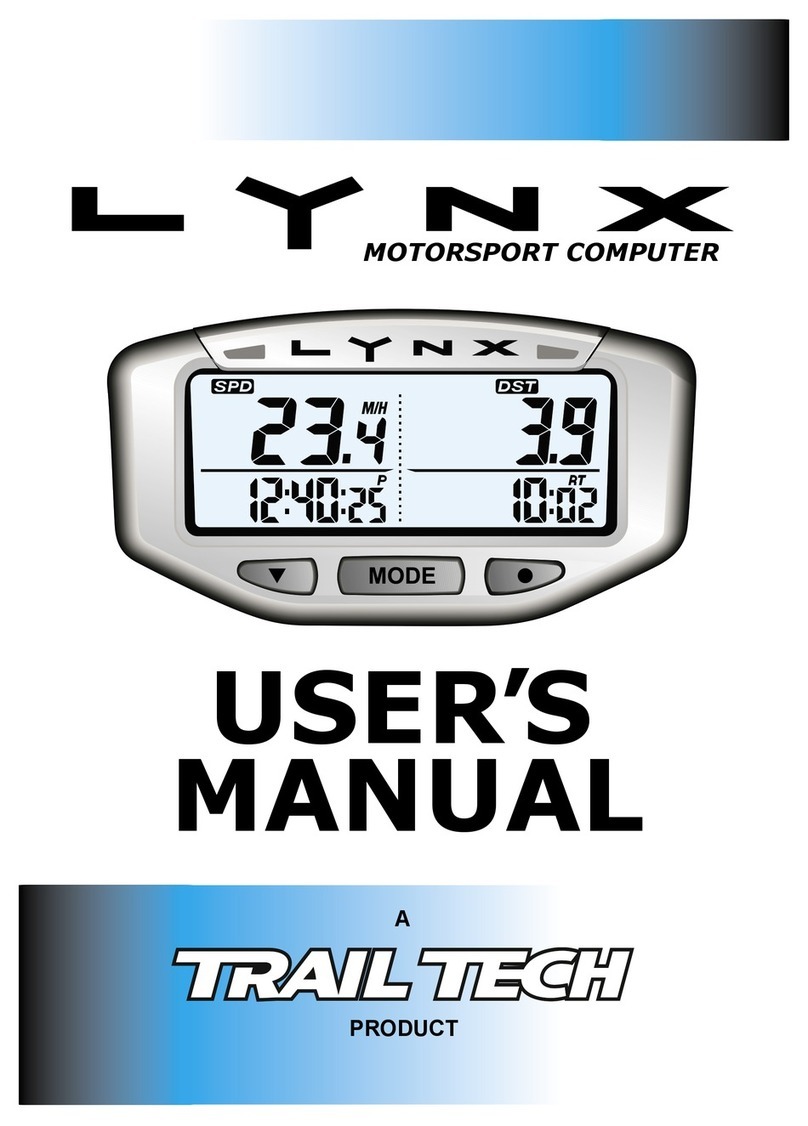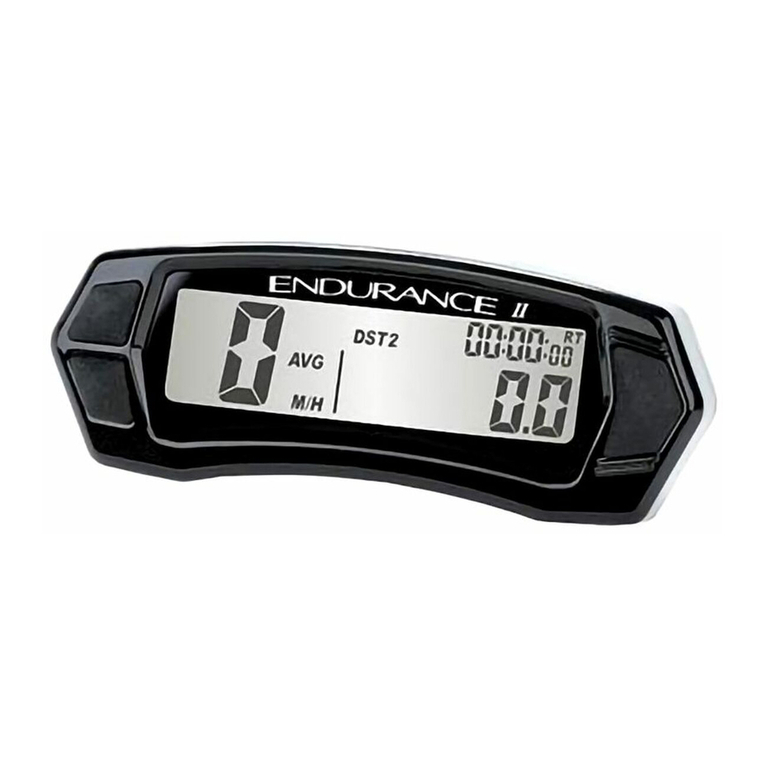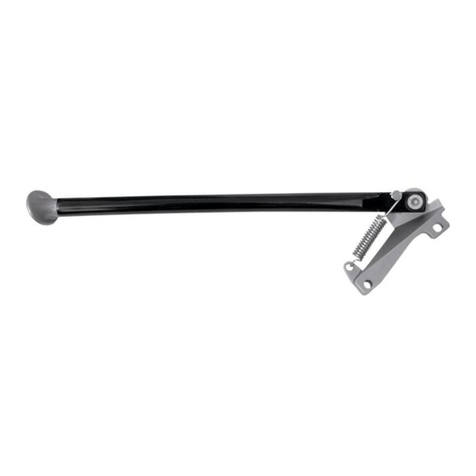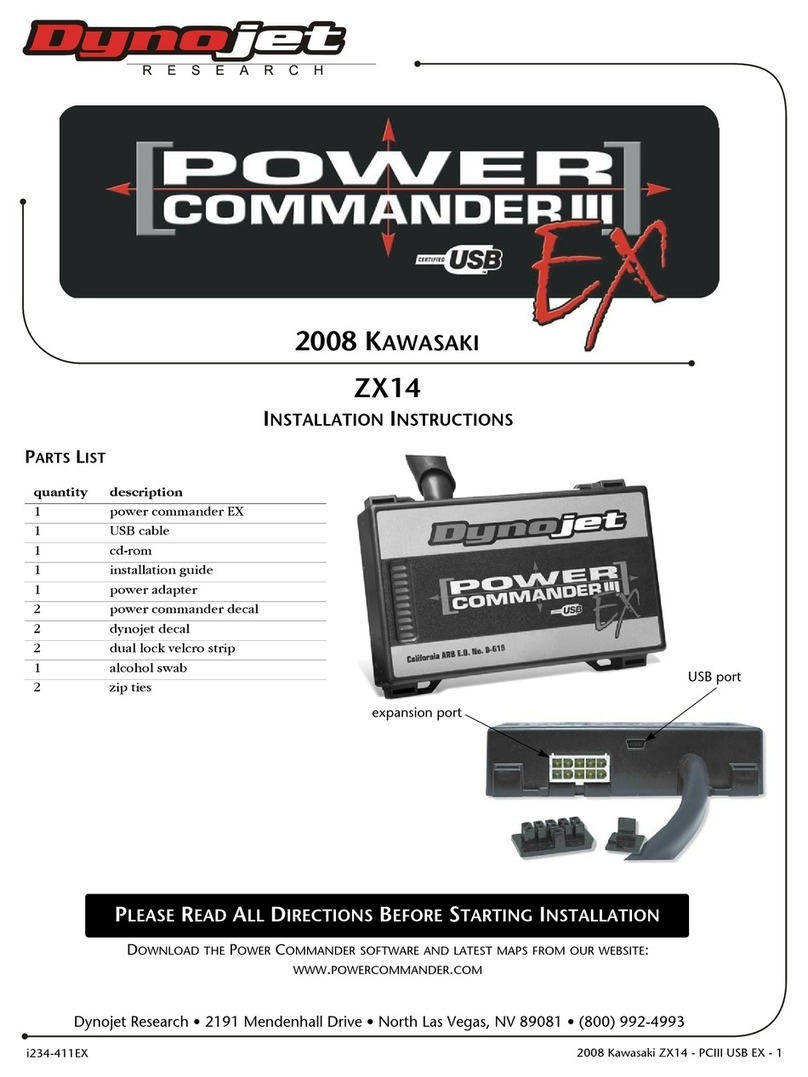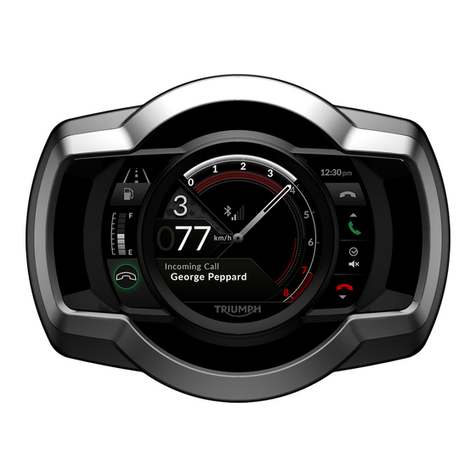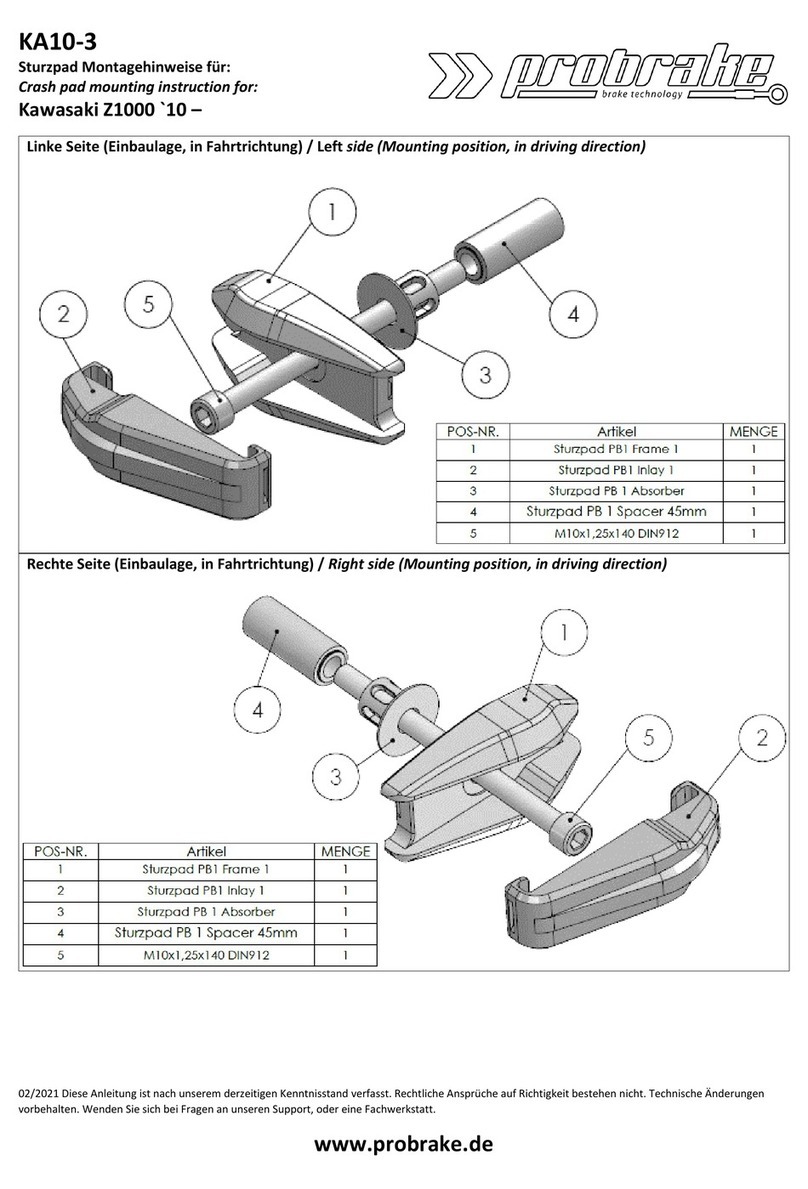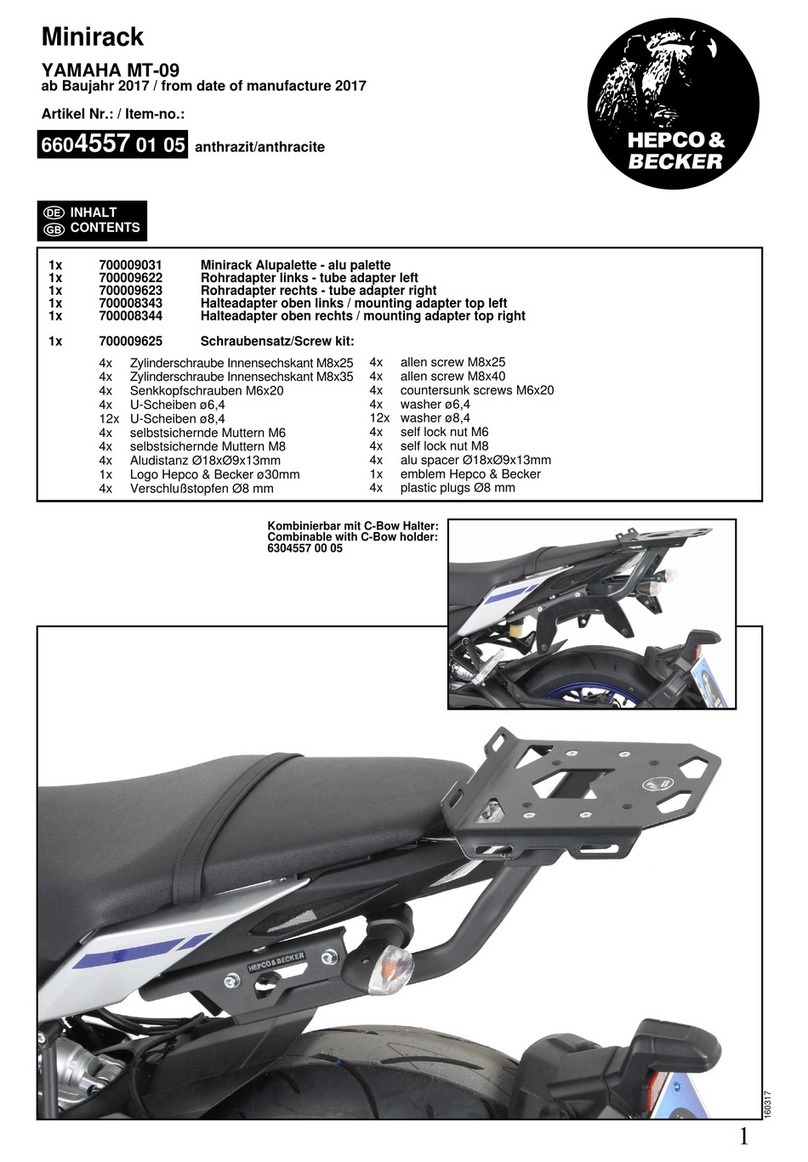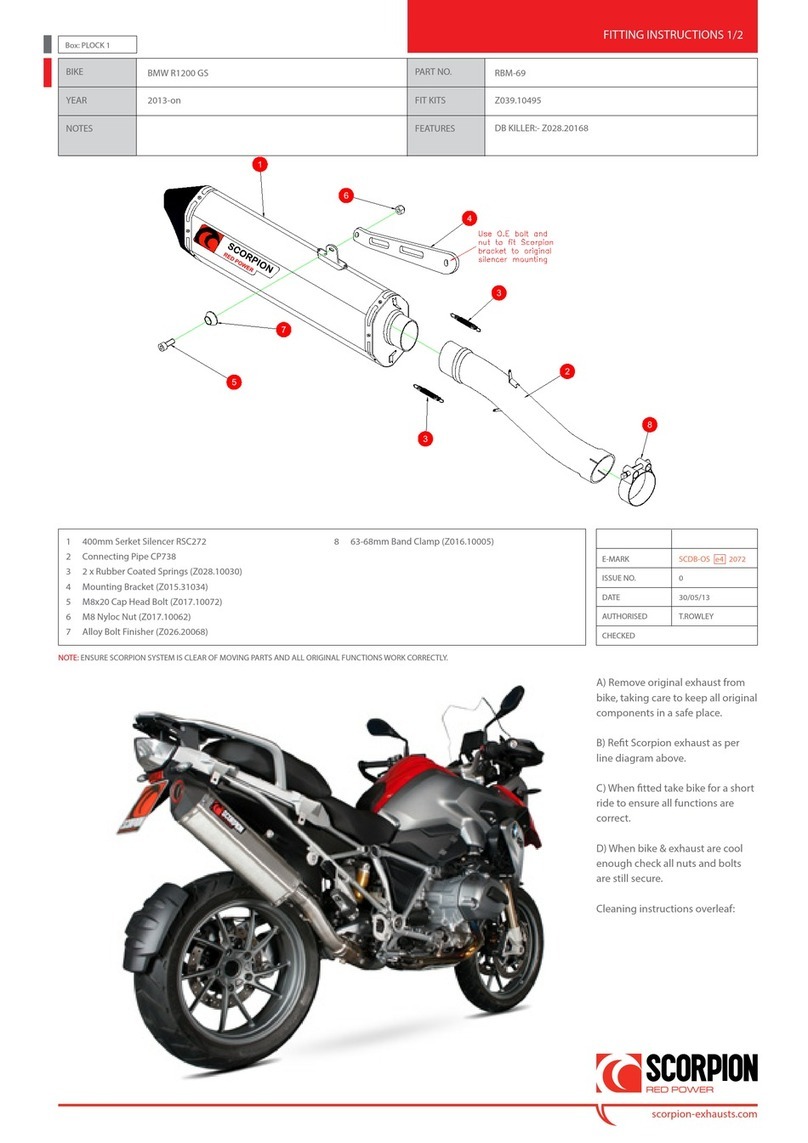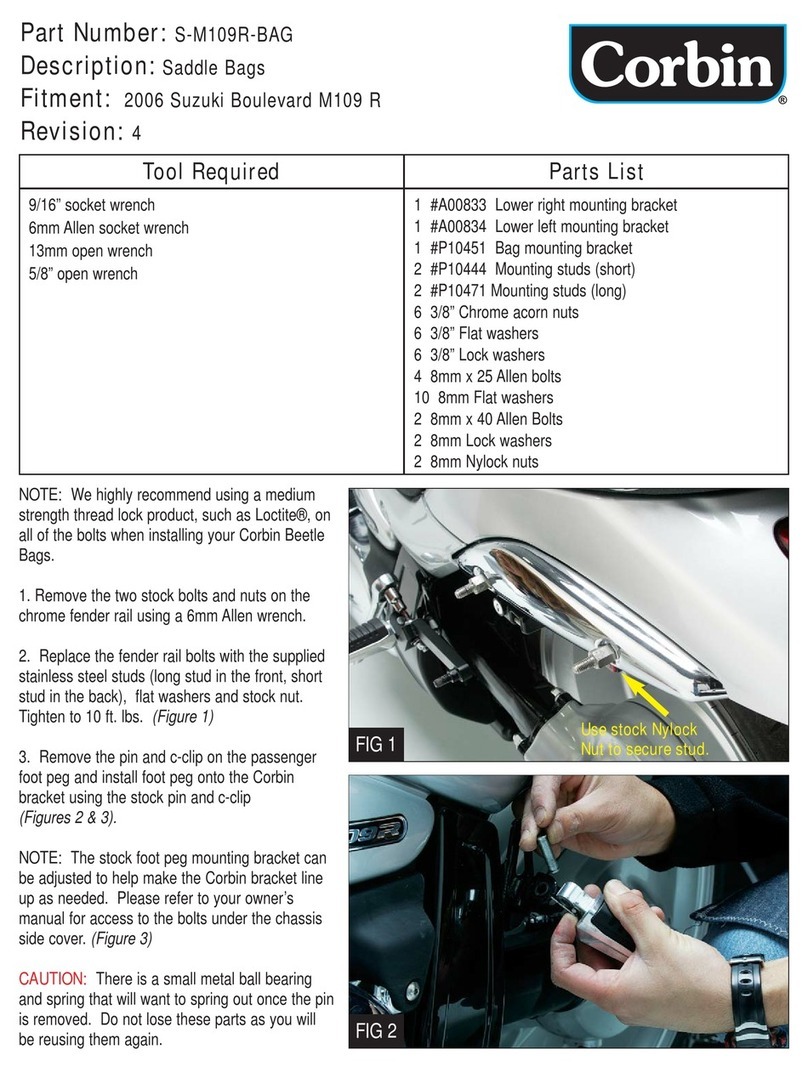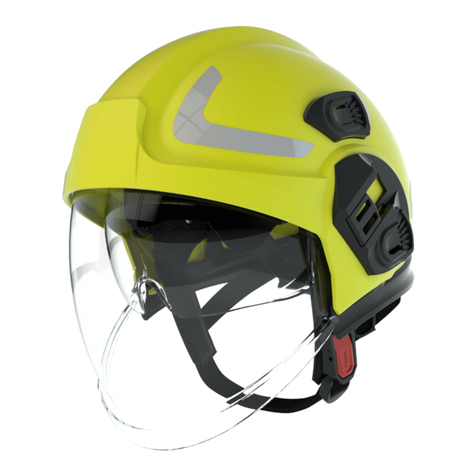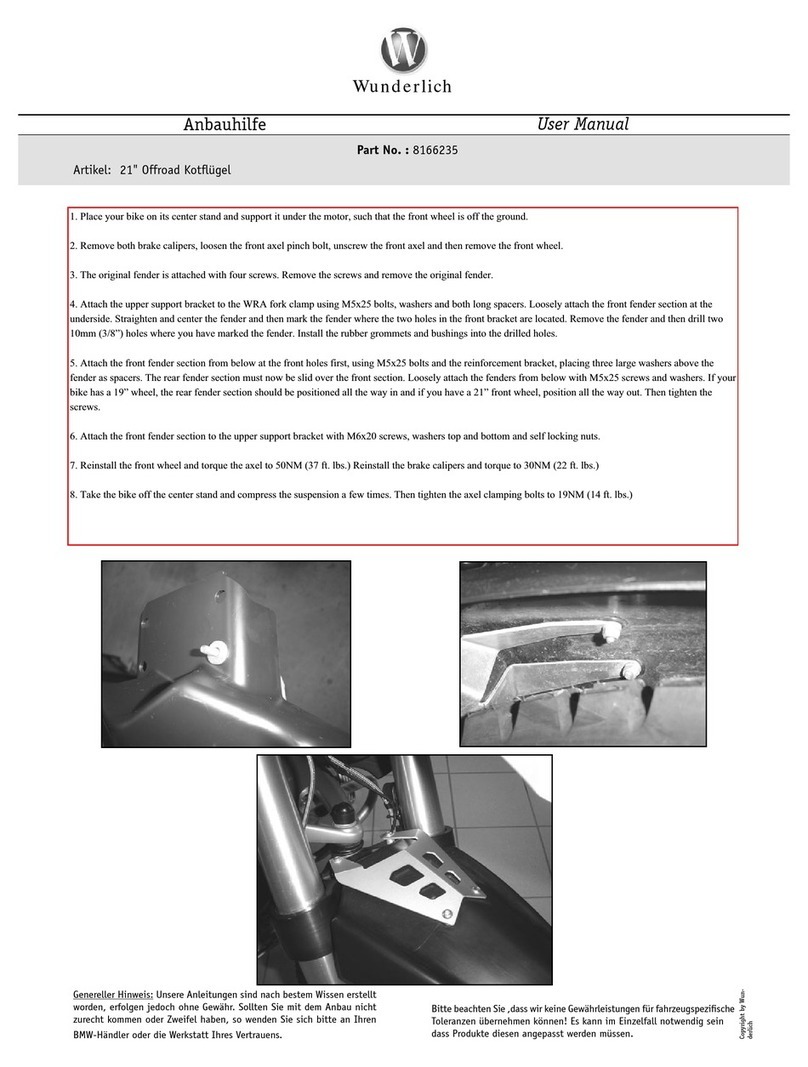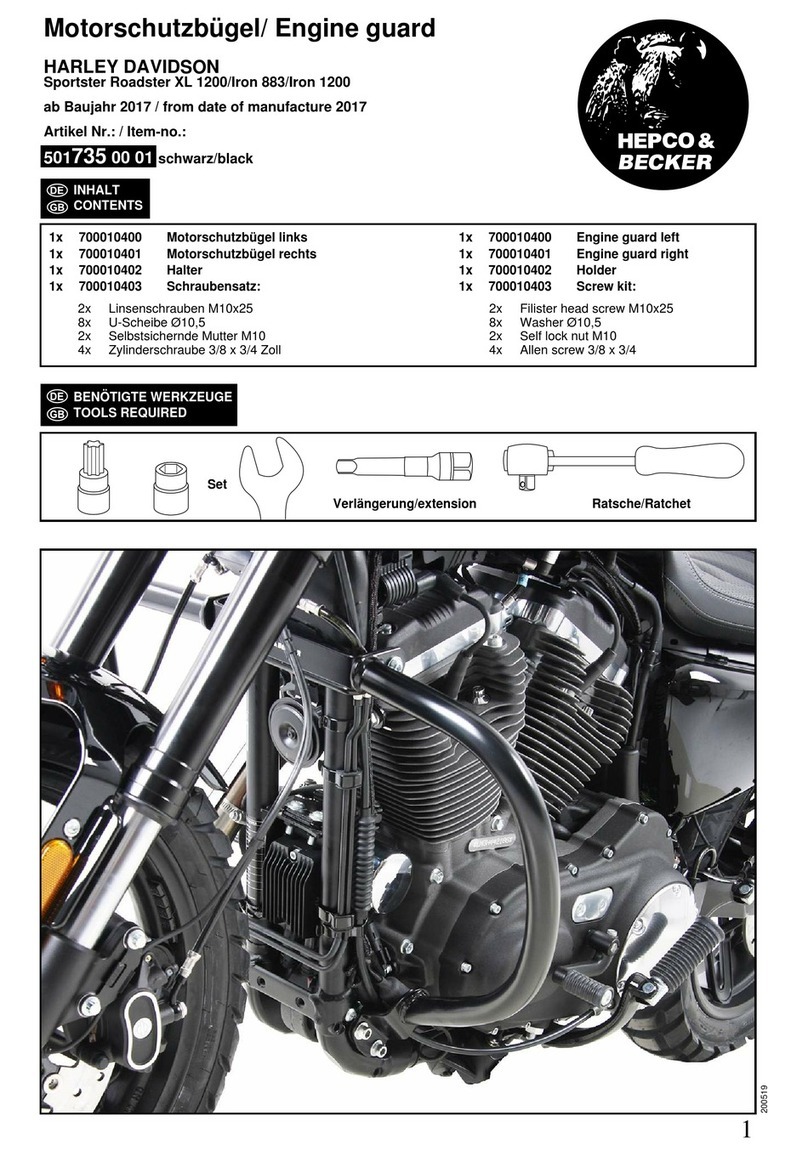Trail Tech Striker CR2032 User manual

3. VEHICLE SENSORS:
Refer to the sensor installation sections.
You should install the wheel sensor,
engine temperature sensor, and
vehicle power connection.
010-ELV-196
QUICK-START
1. POWER OVERVIEW
2. MOUNT STRIKER:
4. INDICATOR LIGHTS:
5. SLEEP MODE:
6. MAINTENANCE ICONS AND LO BATTERY:
Striker operates on the internal 3.0V watch type battery
(#CR2032). If possible, install Striker to the vehicle’s
electrical system. Striker is polarity independent and has
safeguards to avoid draining the vehicle battery. See the
POWER CONNECTION section for more info.
Installing the power wire enables a brighter backlight,
longer sleep timer, and the voltage and
temperature indicator LED’s.
Striker is made to be bolted to the vehicle. Use
the included handlebar mounts, or refer to the
manual.
Striker has two colored LED lights at the top. They are activated when temperature goes above the threshold, or voltage goes below threshold,
to warn you about potential problems with your vehicle. The left LED is yellow, the right LED is red. When the voltage is low the LED will flash, if
the temperature is high then the LED will turn on solid. Set custom thresholds in the DATA SETTING MODE.
Set the thresholds to 0 to turn them off.
If Striker sees no activity (either wheel movement or a button press) for 5 minutes, it will enter sleep mode and only display the clock. Sleep
mode will end when any activity is noticed. During sleep mode Striker is using the internal battery and will not draw down vehicle power.
There are two separate maintenance timers: a WRENCH and an OIL CAN. Set the mileage in DATA SETTING MODE, then Striker will
countdown the miles. When the mileage countdown reaches 0, the icon is displayed. If the internal watch battery voltage gets too low, then
Striker displays a LO icon.
Aluminum
Protector Mount
(optional)
Temperature
Sensor (varies)
Power Wire Wheel Speed
Sensor (varies)
Included
Handlebar
Mount

QUICK-START
9. DATA SETTING MODE :
HOLD DOWN ALL 3 BUTTONS to enter data setting mode.
Adjust one setting at a time, then move on to the next one.
<LEFT> = Scroll value.
<MODE> = Move to next data setting screen.
<RIGHT> = Move to next digit in data setting mode.
7. BUTTONS:
8. SCREENS:
Striker has three screens. Press MODE to toggle between them.
Striker has 3 screens, press MODE to cycle between screens. Hold all three buttons to enter data setting mode.
RESET TRIP DATA:
<LEFT> + <MODE> = HOLD TO RESET VALUES FOR:
Max Speed, Distance, Ride Time, Stop Watch, Max Engine
Temperature, and Max Voltage.
ADJUST TRIP DISTANCE:
<MODE> + 3 sec = ENTER ADJUST MODE
<LEFT>, <RIGHT> = SCROLL VALUE
ORDER OF SETUP MODE:
1. Speed and Distance Format
2. Wheel Size
3. Time Format
4. Time of Day
5. Temperature Unit of Measure
6. Temperature Indicator
7. Temperature Indicator Danger
8. Voltage Indicator
9. Voltage Indicator Danger
10. Oil Maintenance
11. Care Maintenance
12. Average Speed Screen
13. Distance Resolution
M/H or KM/H
See MEASURE WHEEL SIZE section
12H or 24H
12:00:00
°F or °C
Yellow Indicator
Red Indicator
Yellow Indicator
Red Indicator
Distance Countdown
Distance Countdown
Show on Screen 2 or 3
Show 1 or 2 Digits After Decimal
SCREEN 1
• Speed
• Trip Distance
• Clock
• Voltage
• Engine Temperature
• Ride Time
SCREEN 2
• Speed
• Trip Distance
• Clock
• Voltage
• Air Temp
• Stop Watch (TT)
Average speed can be set to show on
screen 2 rather than screen 3, see DATA
SETTING MODE.
SCREEN 3
• Avg Speed
• Max Speed
• Odometer
• Clock
• Accum. Ride TIme
• Max Voltage
• Min Voltage
• Max Engine Temp
Striker alternately displays min/max voltage
and avg/max speed every 2 seconds.
YELLOW
LED
LEFT BUTTON
Start stop watch MODE BUTTON
Switch screens RIGHT BUTTON
Backlight
RED
LED

The Striker sensors plug securely into Striker using waterproof
connectors. They are different sizes (you cannot plug a sensor into
the wrong connector.)
Temperature Sensor: The temperature sensor is mounted in the
radiator hose or cylinder head.
Power Cable: The power wire connects anywhere in the vehicle’s
electrical circuit, or straight to the battery terminals.
Speed Sensor: The speed sensor is mounted to the brake caliper on
the wheel. Without the speed sensor mounted, Striker cannot display
speed or gather distance data.
Remote Switch: Connect the handlebar remote switch accessory
(sold separately) to this connector. The remote switch mirrors the
buttons on the main unit, for accessibility closer to the hand while
riding.
SENSORS
INSTALLS
POWER CONNECTION:
FOR USE ON 6-400 VDC/VAC SYSTEMS ONLY!
Striker will operate in the range of 6-400 VAC/VDC, but will not draw enough power to
drain a vehicle battery. Use a volt meter to confirm 6-400 VDC/VAC. Striker is polarity
independent, so it cannot be installed backwards.
Fuse: Introducing a fuse into the circuit before electronics is always a good idea.
Use a 1 amp fuse with Striker (not provided).
System Tap: It is possible to tap into the vehicle electrical system anywhere in the circuit.
Possible points are at the lights, ignition, or CDI. When tapping into the electrical system,
connect to a circuit protected by fuse.
MX Bikes: Most do, but some motocross bikes do not have 12 volt power. If there is no
vehicle battery or capacitor, connect power wire to ignition power leads from stator.
Use caution, as this is a high voltage option.
Power Wire
SENSORS:
REMOTE SWITCH (OPTIONAL):
Remote Switch
Ambient Temperature Sensor
Engine Temperature Sensor
Wheel Sensor
Vehicle Power
The remote switch is a powerful tool that moves Striker’s buttons
to the handlebar grip. The buttons on the remote switch control
Striker by mirroring Striker’s button functions.
The remote switch is an optional accessory, not included in kits.

TEMPERATURE SENSOR
INSTALLS
TEMPERATURE SENSORS:
Most Striker kits contain a model-specific temperature sensor. Installing the temperature sensor enables
temperature readouts on Striker. Alternative sensors are available.
Vehicles cooled with water use sensors to measure the fluid temperature, while air-cooled machines take
the cylinder head’s temperature at the spark plug. The radiator fin sensor is the easiest installation for
water cooled applications.
CVT Sensor Install:
(Continuously Variable Transmission)
200ºF+ Warning: CVT Belt wear occurs
more rapidly at high temperatures.
Let the belt cool down to increase lifespan.
Drill 13/64” (5mm) hole in
hard plastic CVT exhaust.
Thread sensor into hole.
The sensor threads are M6x10.
Use high temp RTV (silicone
gasket sealer) to seal case cover.
Not included in kit.
1.
2.
3.
Radiator Hose
Sensor Installation:
Drain uid.
Measure inner diameter
of hose before cutting.
Mark hose.
Cut hose.
Slide on hose clamps.
Install sensor & tighten
hose clamps.
1.
2.
3.
4.
5.
6.
Mark
& Cut
Tighten
CHT Cylinder Head
Spark Plug
Sensor Installation:
Remove crush
washer from
spark plug.
Replace with
temperature
sensor.
Re-install
spark plug.
1.
2.
3.
Sensor replaces
crush washer
Radiator Fin
Sensor Installation:
Conrm correct size.
Apply thermal grease to
maximize heat transfer.
Carefully press sensor
between radiator ns.
1.
2.
3.
If the in sensor is too large,
le it to size rather than
forcing it into the radiator.
Screw
Sensor Installation:
1.
2.
Remove radiator pressure
relief bolt.
Replace with temperature
sensor.

WHEEL SENSORS
INSTALLS
Some ATVs require
mounting the wheel
sensor directly to the
brake caliper.
Drill a 1/8” hole
through the caliper
mount, then use the
self-tapping screw to
secure the sensor.
BRAKE CALIPER WHEEL SENSOR
Brake Caliper
Wheel Sensor
If the fork is close to
the brake rotor, then
the VHB fork sensor
can be used. Peel
and stick the sensor
to the fork.
Try to have the tip of
the sensor about 1/2
inch away from the
magnet in the rotor.
CONVENTIONAL FORK SENSOR
Rotor Bolt Magnet Conventional Fork
VHB Wheel Sensor
Some kits include
a metal C-bracket
to help mount the
sensor, as shown.
Use the jam nuts to
secure the sensor to
the C-bracket. Use
loctite rather than
over-tightening the
jam nuts.
C-BRACKET WHEEL SENSOR
C-Bracket
Wheel Sensor
Trail Tech wheel
sensors work with the
KTM and Husqvarna
OEM install location.
Screw the wheel
sensor into the OEM
caliper position. Insert
the black magnet into
the pre-drilled hole in
the rotor and secure
with the retainer clip.
KTM WHEEL SENSOR
KTM Magnetic
Retainer KTM OEM Wheel
Sensor Position
If there are fork
guards next to the
brake rotor, then the
fork guard wheel
sensor can be
installed as shown.
Try to have the tip of
the sensor about 1/2
inch away from the
magnet in the rotor.
INVERTED FORK WHEEL SENSOR
Rotor Bolt Magnet Inverted Fork
Wheel Sensor Rotor Shield
Wheel Sensor
For UTVs and quads
with a rotor shield,
position the sensor
there.
Drill a 3/8” hole and
use the jam nuts to
secure the sensor to
the rotor shield. Use
loctite rather than
over-tightening the
jam nuts.
ROTOR SHIELD WHEEL SENSOR
MAGNET INSTALLATION:
Install a magnet on the brake rotor to trigger
the speed sensor each wheel rotation.
Remove one of the stock rotor bolts and
install the magnetic rotor bolt as shown, do
not overtighten past 10 ft-lb of torque. If the
magnetic bolt will not work, the kit includes a
spare magnet that can be installed into one
of the rotor spaces. Use the included retainer
clip or epoxy such as JB Weld to secure. Magnetic Retainer or Spare MagnetMagnetic Rotor Bolt

X = 2131
X = 5 x 2110
4.95
(new wheel size) (actual miles) x (current wheel size)
(current miles)
=
X = 10550
4.95
MEASURE WHEEL SIZE:
WHEEL SENSOR TEST:
Test for correct sensor/magnet placement before permanently mounting.
1. Set the vehicle on a stand so that the front (left) wheel spins easily.
2. Plug the wheel sensor cable into the computer.
3. Install the magnetic bolt.
4. Hold the sensor in place on the caliper mount by hand. While someone
watches the computer, roll the wheel. If the computer does not register,
move the magnet or sensor and try again. There should be 1/2” or less
gap between the sensor and magnet.
Do not mount so that the magnet passes the middle section of the
sensor. Either the sensor will not register at all; or the sensor will
register twice, causing a “double trigger” effect (computer displays
twice the true speed.) If a double-trigger is unavoidable, divide the wheel
size setting in the computer by 2 to correct the problem.
Magnet Rotation Path
Knowing your exact wheel size it critical for the wheel sensor to calculate
correct speed and distance data.
When comparing calibration to GPS data, use a long straight section of road
with no tight corners or small vertical movements.
On a at surface, mark the tire sidewall and the ground with a marking pen. Roll the
wheel until the mark on the tire completes one revolution and is back on the ground. Mark
the ground at this location. Measure the distance between the marks on the ground in
millimeters (multiply inches by 25.4 to convert to mm). Use this number for your wheel size.
For accuracy, the rider’s weight should be on the bike when making the measurement.
Method 2: Rolling
Find the circumference of front wheel by measuring its diameter in millimeters.
Multiply the Wheel Diameter by 3.14. The result is your wheel size.
Method 1: Ruler
Enter the number you calculate from one of
the above formulas into setup mode.
Method 3: Distance Measurement
This is the most accurate method.
1. Set the wheel size to 2110mm (motorcycle) or 1675 (ATV).
2. Find a length of road where the distance is known.
3. Ride the distance, noting how far the computer reads (i.e. the road
is known to be 5 miles and the computer shows 4.95 miles.)
4. Use the numbers to solve for X in the following equation:
Wheel Size =
Wheel Diameter(mm)
x3.14
Diameter
x3.14
Wheel Size:
Motorcycle:
ATV: 2110 mm
1675 mm
Generic/Average Sizes:
WHEEL SENSORS
SETUP
Learn more about other motorcycle dashboard & gauges by Trail Tech on our website.
Table of contents
Other Trail Tech Motorcycle Accessories manuals
Popular Motorcycle Accessories manuals by other brands
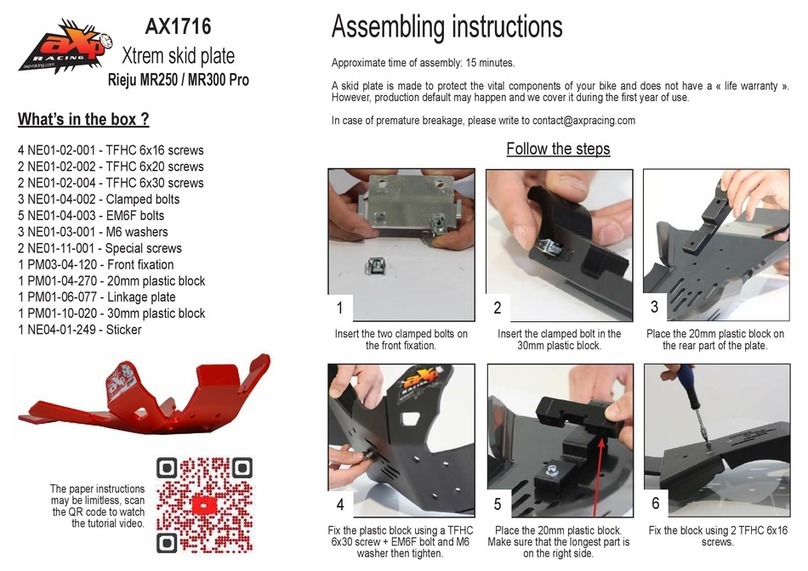
aXp RACING
aXp RACING AX1716 Assembling instructions
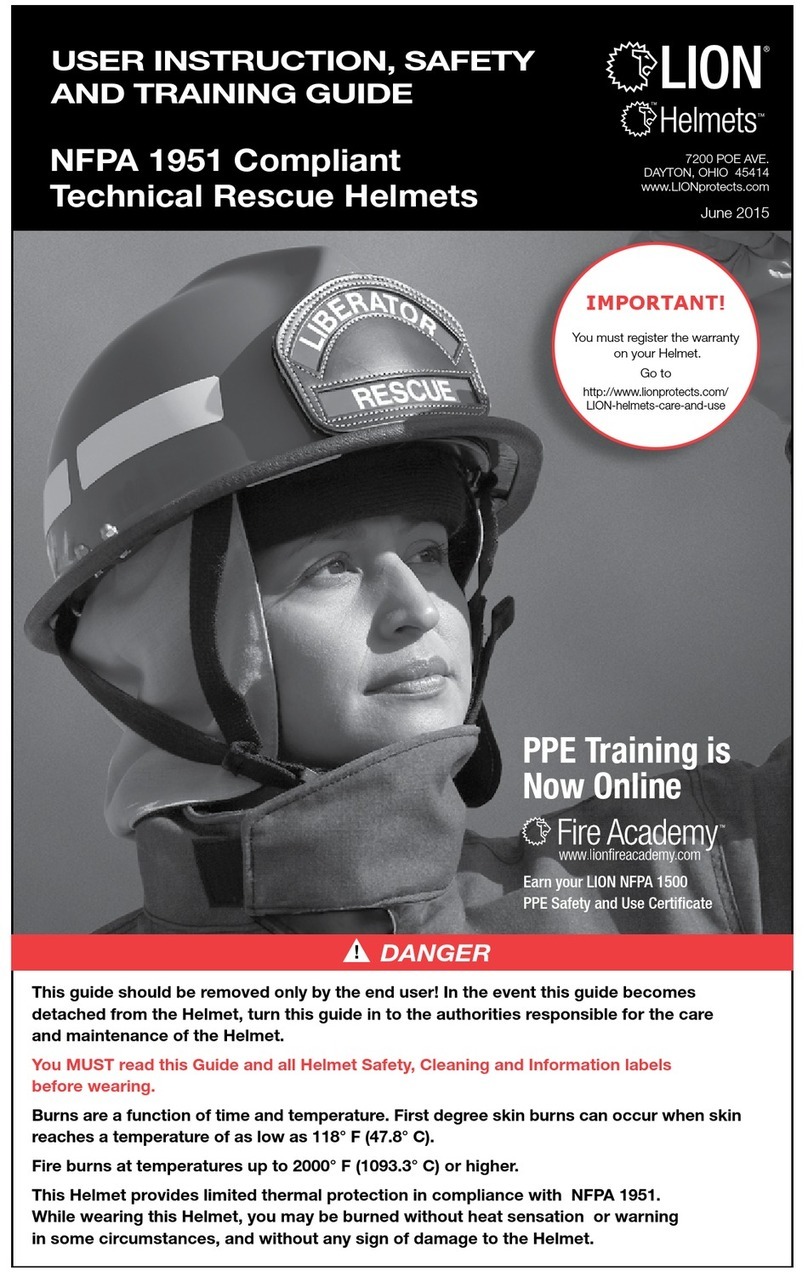
LION
LION LIBERATOR USER INSTRUCTION, SAFETY AND TRAINING GUIDE
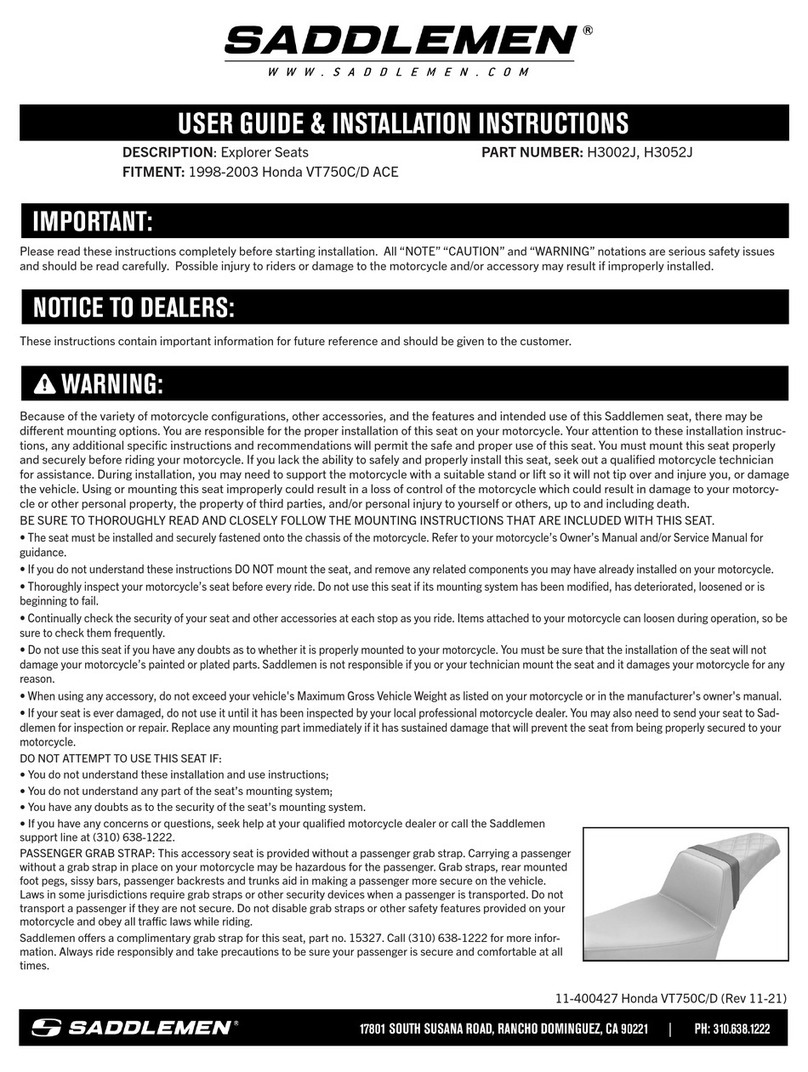
Saddlemen
Saddlemen H3002J User's guide & installation instructions
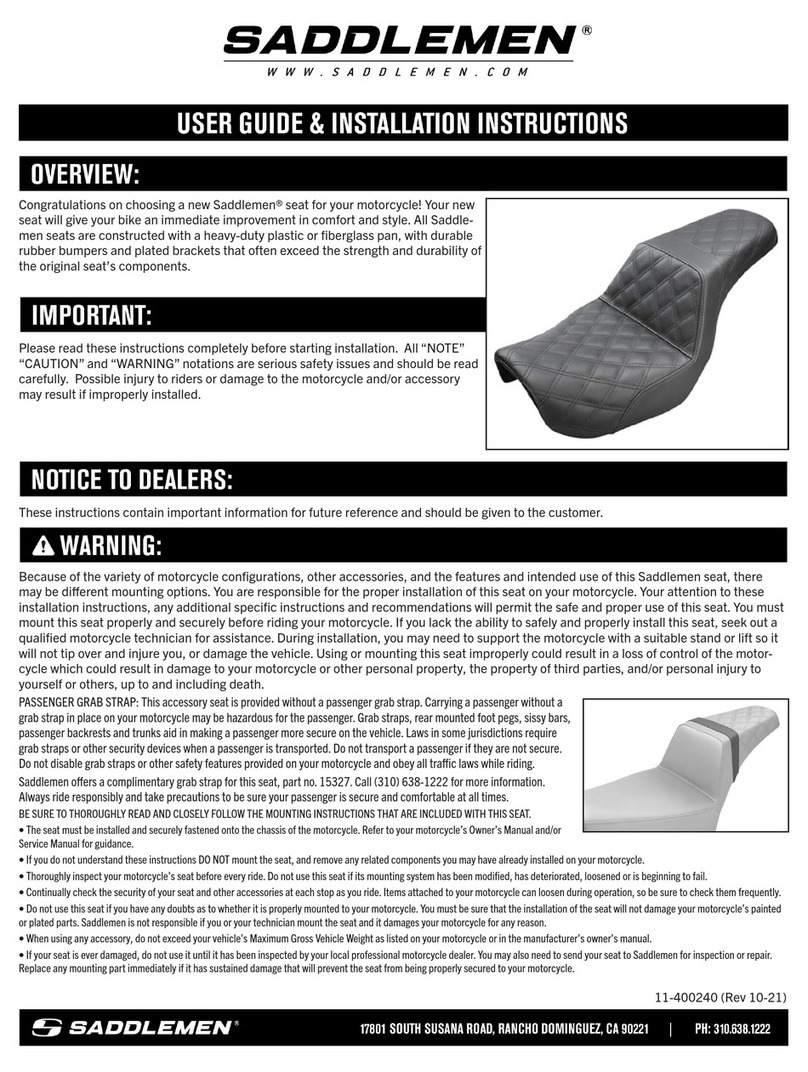
Saddlemen
Saddlemen K06-11-0112 User's guide & installation instructions
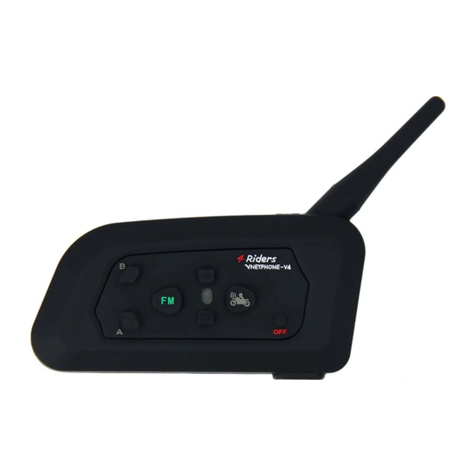
VnetPhone
VnetPhone Riders V4 user manual
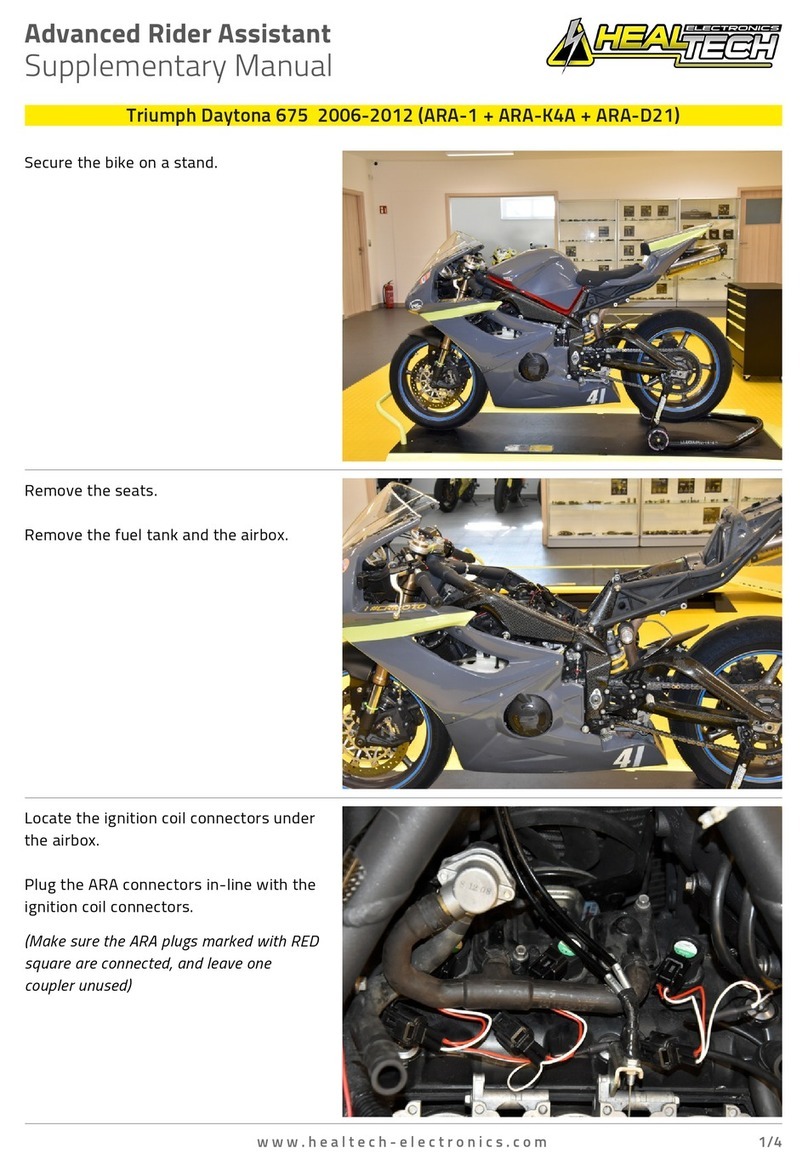
HealTech Electronics
HealTech Electronics Advanced Rider Assistant Supplementary manual
